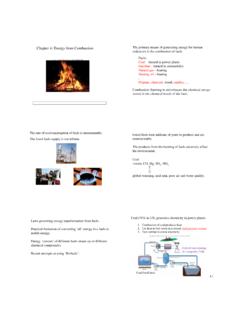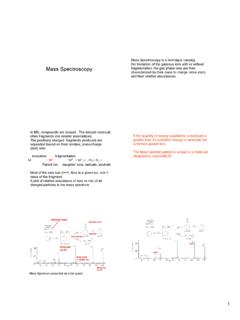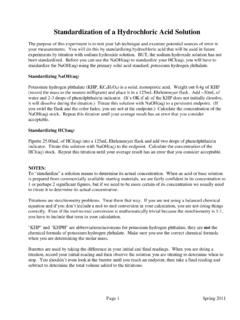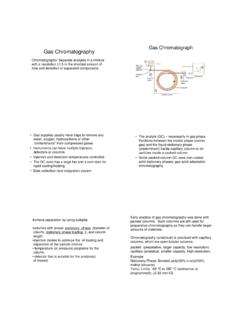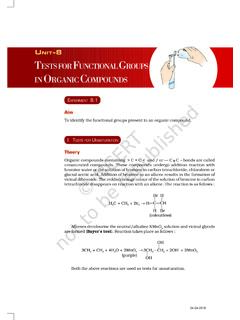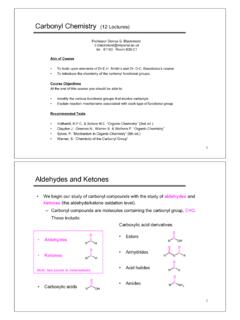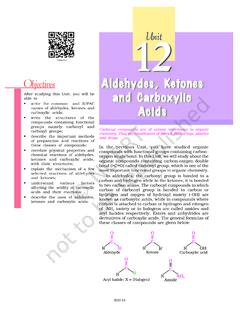Transcription of Reactions of Amines
1 Chem 360 Jasperse Ch. 19 Notes + Answers. Amines 1 Reactions of Amines 1. Reaction as a proton base (Section 19-5 and 19-6) RNHHNHHRHXH-X(proton acid)NaOHaminebaseammonium salt(acidic) Mechanism: Required (protonation) Reverse Mechanism: Required (deprotonation) Amines are completely converted to ammonium salts by acids Ammonium salts are completely neutralized back to Amines by bases Patterns in base strength: Reflect stabilization/destabilization factors on both the amine and the ammonium o N lone pair: sp3 > sp2 > p o For sp3 nitrogens, 3 > 2 > 1 2. Reaction with Ketones or aldehydes (Section 18-16,17 and 19-10) R'ROaldehyde or ketoneZNH2, H+R'NHZOHR tetrahedral"aminol"H+, -H2OH2O, H+, -ZNH2H2O, H+imineR'RNZ Notes: Z can be a carbon, nitrogen, oxygen, or hydrogen atom/group.
2 The aminol can t be isolated, it s only present at equilibrium. Equilibrium factors apply. Water drives to the carbonyl side; removal of water drives to the imine side. Mechanism: Learned for last test (not tested this time) Must have at least 2 H s on nitrogen 2 , 3 Amines can t do this Chem 360 Jasperse Ch. 19 Notes + Answers. Amines 2 3. Alkylation of 1 Alkyl Halides (Section 19-12, 19-21A) RBrRNHHNHRHX ammonium saltR 3a. Polyalkylation is routine. o With excess alkyl halide and base, keep on alkylating until it becomes the quaternary ammonium salt (no surviving H s on nitrogen, examples below).
3 Mechanism required for polylalkylations. The mechanism involves repetitive sequential SN2 alkylation-deprotonations. PhNH23 CH3-BrNaHCO3 PhNCH3CH3H3 CBrNH2 CH3CH2-BrNaHCO3 NBrEt3 NEt3 NCH2 PhBrPhCH2-Br 3b. Monosubstitution is possible when excess ammonia (or other cheap Amines ) is used. Mechanism for monosubstitution required. This involves simple SN2, followed by deprotonation by the excess amine. Brexcess NH3NH2 4. Acylation with Acid Chlorides to From Amides: (Section 19-13, 20-15) RNR1OR2 HNR1R2 RClObase required(either excess amine, or NaOH or NaHCO3, or NEt3 or ) Mechanism: Required (addition-elimination-deprotonation) Amine must have at least one hydrogen to begin.
4 But 1 , 2 , or NH3 all react well. But 3 Amines can t work. Some base is required for the deprotonation step and to absorb the HCl. For cheap Amines , excess amine can simply be used. Alternatively, Amines with no H s (triethylamine, pyridine) can be used. Or else NaOH or NaHCO3 can be used. Chem 360 Jasperse Ch. 19 Notes + Answers. Amines 3 4b. Acylation with Carboxylic Acids to From Amides: (Section 20-12) RNR1OR2 HNR1R2 RHOO heat Mechanism: Not Required Fairly high temperatures often required, and yields aren t as good as with acid chlorides Biologically amine + acid amide is routine, and is facilitated by complex enzyme mechanisms 5.
5 Substitution for Aromatic Amines via the Diazonium Salts ( The Sandmeyer Reaction ) (Section 19-17, 18) ArNH2 NaNO2, HClArN2 CldiazoniumsaltCuCNH3PO2H2O, H+, heatArClCuClArBrCuBrArCNArOHArH Mechanism: Not Required Qualitatively, can think of this as a nucleophilic substitution: a nucleophile replaces N2, a premier leaving group. The actual mechanism is probably radical, however. Application in synthesis: The amine (an o/p director) is often derived from a nitro (a meta director). Using the nitro group to direct meta, then reducing and converting the nitrogen into CN, Br, Cl, OH, or H, provides products we haven t been able to make before.
6 Chem 360 Jasperse Ch. 19 Synthesis of Amines 4 Synthesis of Amines 6. From aldehydes or Ketones: Reductive Amination (Section 19-19) RR1 OKetone oraldehyde+HNR3R2 NaBH3 CNcat. H+RR1 HNR3R2viaRR1NR3R2 Access: 1 , 2 , or 3 Amines Mechanism: Not required. (Basic workup) The carbonyl reactant can be an aldehyde or a ketone The amine reactant must have at least one hydrogen, as shown above; but R2 and/or R3 can be either a carbon or a hydrogen. Thus: o NH3 1 RNH2 o 1 RNH2 2 R2NH o 2 R2NH 3 R3N o 3 R3N don t react RR1 OKetone oraldehyde+HNHR2 NaBH3 CNcat. H+RR1 HNHR2viaRR1 NHR2RR1 OKetone oraldehyde+HNHHNaBH3 CNcat.
7 H+RR1 HNHHviaRR1 NHHammonia1 amine1 amine2 amineRR1 OKetone oraldehyde+HNR3R2 NaBH3 CNcat. H+RR1 HNR3R2viaRR1NR3R22 amine3 amine 7. Via Amides: (Section 19-20) RNR1OR2 LiAlH4 RNR1R2 No mechanism required for the reduction Access: 1 , 2 , or 3 Amines . R1 and R2 can be either H or C. Thus, you can produce either 1 , 2 , or 3 Amines in this way: o RCONH2 1 RCH2NH2 o RCONHR 2 RCH2 NHR o RCONR2 3 RCH2NR2 Chem 360 Jasperse Ch. 19 Synthesis of Amines 5 8. From Amines via Amides: (Section 19-20) RNR1OR2 LiAlH4 RNR1R2 HNR1R2 RClO+acylationRNR1OR2 LiAlH4 RNR1R2 HNR1R2 ROHO+acylationheat Access: 1 , 2 , or 3 Amines Acylation mechanism required (see reaction 4) but reduction mechanism not required.
8 9. Reduction of nitro compounds: (section 19-21C) NO2Fe, HClNH2 Access: 1 Amines only (especially aromatic Amines ) No mechanism required. There are many other recipes for reduction of nitro compounds: o Pd/H2, Ni/H2, Pt/H2, o Fe/HCl, Zn/HCl, Sn/HCl 10. From 1 Alkyl Halides: Alkylation of Ammonia (Section 19-12, 19-21A) (See reaction 3). RBrexcess NH3 RNH2 Access: 1 Amines only Mechanism required. (see reaction 3b) No change in number of carbons. Excess NH3 prevents polysubstitution. 11. From Nitriles: Reduction of Nitriles (Section 19-21B) RNH2 CNRLiAlH4 Access: 1 Amines Mechanism not required.
9 12. From Alkyl Halides: Via the Nitrile (Section 19-21B) NH2 RRCNRBr1. KCN2. LiAlH4 Access: 1 Amines only Mechanism not required. One-Carbon chain extension! Chem 360 Jasperse Ch. 19 Synthesis of Amines 6 Summary of Amine Syntheses Route Reaction Number Source/ Precursor Reagent Available Amines Comments 1 #6 aldehydes or Ketones R2NH, H+ NaBH3CN, 1 , 2 , or 3 Amines 2 #7, #8 Amides LiAlH4 1 , 2 , or 3 Amines 3 #7, #8 Amines (via Amide) 1. RCOCl (or RCO2H, heat) 2. LiAlH4 1 ArNH2 4 #7, #8 Acid Chlorides or Acids (via Amide) 1. RNH2 2. LiAlH4 5 #9 ArNO2 Fe/HCl 1 ArNH2 6 #10 1 RCH2Br NH3 (excess) 1 only, with CH2 next to nitrogen Original carbon chain is not extended 1.
10 7 #12 1 RCH2Br (via nitrile) 2. KCN 3. LiAlH4 1 only, with CH2 next to nitrogen Original carbon chain is extended by one carbon 8 #11 RCH2CN LiAlH4 1 only, with CH2 next to nitrogen Chem 360 Jasperse Ch. 19 Mechanisms 7 Mechanisms 1. Protonation NH2 HClNH3Cl Deprotonation NHHHOHNH2 3. Polyalkylation Ex: PhNH23 BrNaOHPhNEtEtEtBr Mech: PhNH2 BrPhNHEtHOHPhNHEtPhNHEtEtPhNEt2 OHPhNEtEtEtBrBrSN2SN2SN2 DeprotonateDeprotonate 3b. Monoalkylation OHDeprotonateBrNH3SN2NH3NH2 Chem 360 Jasperse Ch. 19 Mechanisms 8 4. Acylation Ex: NH2 ClONaOHNHO Mech: 3 steps: Addition-Elimination-Deprotonation OHNH2 ClONHONHHOClNHHOAddElimDeprotonate Chem 360 Jasperse Ch.

